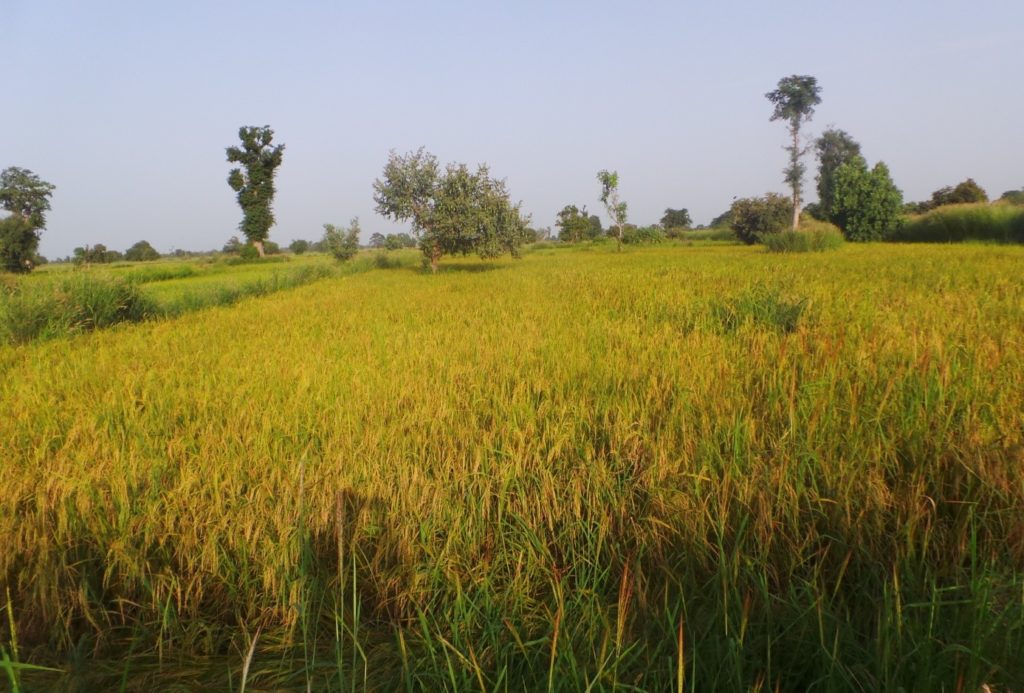Gambia: Promoting access to fertilizer and improved seed enhances rice productivity

By Mamadou Edrisa Njie
Rice production in The Gambia is characterized by low productivity and production, consequently resulting in low revenues for farmers engaged in the rice value chain. Rice yields in the country have remained extremely low over the last 2 decades. Gambia continues to rely heavily on importation to meet its national rice consumption needs, with rice imports accounting for at least 70% of total consumption.
Key factors contributing to this poor performance include low land productivity and widespread use of poor quality and low-yielding rice varieties. Over the past decade, efforts have been made to address these issues through the adaptation of improved varieties across the key rice ecologies.
This includes the introduction of improved NERICA and ARICA rice varieties in partnership with Africa Rice, the key international rice research and development institution in the region. A major issue, however, relates to accessibility as well as large-scale adoption of these varieties.
Although the varieties are considered suitable and adapted to various rice growing environments across the country, actual performance of most varieties have been consistently lower than the potentials. This is due in part to conditions such as the very low inherent fertility of Gambia soils.
A holistic approach to addressing these issues will contribute significantly to improving rice productivity and increasing overall production. This will consequently, result in increased incomes for rice farmers as well reduction in rice importation.
The National Agricultural Land and Water Management Development Project (Nema-Chosso) is enhancing rice productivity and production through increased access to fertilizers and quality rice seed.
Since 2017, the International Fund for Agricultural Development (IFAD) funded Nema-Chosso has been supporting increased access to fertilizer and rice seeds as a means of enabling rice farmers to increase their productivity, production and revenues. Targeting selected rice farmer organizations at the village level, a three-pronged approach consisting of facilitating linkages to major fertilizer suppliers, providing guarantees as well as an up-front 50% subsidy, resulted in enhancing immediate access to fertilizers for rice production.
In addition to this, the project invested in the multiplication and distribution of quality seed of farmer-selected improved rice varieties. In partnership with the National Seed Secretariat and the Directorate of Agriculture, quality seed of improved varieties were made available to producers across the Gambia.
The Nema-Chosso’s Knowledge Management and Communications Officer, Mr. Bakary Jammeh spoke on the effectively facilitated tripartite negotiations between the Gambia Groundnut Council (fertilizer source), farmer organization representatives and the project for bulk supply of fertilizer for rice production.
In his explanation on the arrangement, Nema would provide a 50% subsidy at the wholesale price as well as a guarantee to Gambia Groundnut Co-operation (GGC) for a loan of the balance 50% to the farmer organizations.
The groups, as Jammeh indicated, would in-turn make the fertilizer available to their members at agreed retail market prices. Benefits accrued by the said groups would support their operationalization and capacities to progressively take over the initiative.
The Knowledge and Communications Officer is positive that, with this initiative, immediate access to fertilizer would enable rice farmers to enhance productivity and increase their production.
“Ensuring sustainability requires that farmer organizations be in a position to progressively take over the initiative and continue facilitating access to fertilizers and seed for their members,” the Nema-Chosso official underlined.
Achievements and effects
Since the inception of this initiative in 2017, 26 rice producer groups across more than 25 villages have been supported to facilitate access to fertilizer and quality seed of improved rice varieties for their members. The groups have been clustered into 6 farmer cooperatives to facilitate coordination and enhance their collective bargaining power.
The 6 clusters are organized around communities in Boiram and Kudang in the Central River Region/South; Salikenne and Jurunku in the North Bank Region; Pakalinding in the Lower River Region; and Barajally Suba in the Central River Region/North. The six cooperatives have a collective membership of more than 12,000 women and men.
The initiative improved access to fertilizer for rice production for the more than 12,000 members of the cooperatives. In 2017, 220 and 230 tons of NPK and Urea, respectively, were made available to farmers across the 6 cooperatives. Producer members of the cooperatives also had access to tons of quality seed of selected rice varieties (Sahel134, IR19746, IET3137 and WAB 105).
The combined effect of these two initiatives was a significant increase in yields as well as the total area under rice cultivation in the targeted intervention areas. The outreach, yield and production effects of the fertilizer and quality seed initiatives are shared by cooperative members of Boiram and Jurunku, respectively.
Access to fertilizer and seed
Hawa Jange, a native of Boiram village and President of the Boiram Cluster Cooperative in the Central River Region/South, recounts how access to fertilizer and seed has improved rice yields and revenues, noting that rice production has been a key agricultural activity and source of income for basically all households in her community, for decades.
“We cultivate about 350 hectares of rice, with women as the principal rice producers. Transformation and other post-harvest operations also provide incomes for our communities.
“Our principal challenge, however, is the low rice yields due to continuous cropping on poor soils, use of poor-quality rice seeds and very limited access to fertilizer. With support from Nema, however, communities in our cluster had access to 2000 50Kg-bags of fertilizer during our first year of participation in this initiative,” Mrs. Jagne disclosed to this medium. As she also observed, the number of members in her Cooperative has increased significantly in 2018, as “we were able to procure more than 5,700 bags to meet the increasing demand from our membership”.
Consequently, she went on, rice yields and overall production in the area have increased dramatically; and that average yields of beneficiaries increased from 1.8 t/ha traditionally to 3.5 t/ha over the two-year period. Increase in yield has a direct positive relationship with incomes. “Our earnings have also more than doubled, as a result…”, she concluded.
At Jurunku in the North Bank Region, women are producing enough rice to meet their household needs, thanks to Nema-Chosso. Rice production in the Jurunku cluster is largely subsistence, and women struggle to produce enough to meet their household needs due to limited access to key inputs like fertilizer. But with support from the project, the Jurunku cluster cooperative procured 600 and 1300 bags of fertilizer in 2017 and 2018, respectively. This, it could be noted, was made available to its members at ongoing market retail prices. In addition to this, the project provided 30 bags of quality seed of improved rice varieties selected by the beneficiaries.
The effects of this initiative are highlighted by Mrs. Jija Drammeh a smallholder rice producer in the village: “With access to fertilizer and improved seed, my yields have increased from 1.5 to more than 4.0 tons per hectare. My overall production increased by 50%.
| “For the first time ever, my total production has exceeded my household rice consumption needs. I now have the unexpected opportunity to sell surplus rice for much needed household income with which I can support my family. I am now able to contribute to the schooling and clothing of my children, making me a proud mother.”
|
Lessons
- Collective group action by farmers with otherwise low individual purchasing and bargaining powers is an effective way of facilitating access to improved inputs for small scale-farmers.
- Leveraging project resources for loan guarantees as well as part-financing with a clear strategy for ownership and sustainability are key drivers of the success of this initiative
- Capacity development support is essential for effective organizational management and the ability of the cooperatives to respond to the needs of their members and take appropriate measures to meet their contractual obligations with the GGC.
Perspectives
- Continued capacity development support to cooperatives for effective management of resources and a business approach to agriculture
- Linking cooperatives to other actors of the rice value chain across key sites
- Supporting the development of sustainable agricultural financing strategy in partnership with the National Cooperative Credit Union of The Gambia (NACCUG).


Comments are closed.